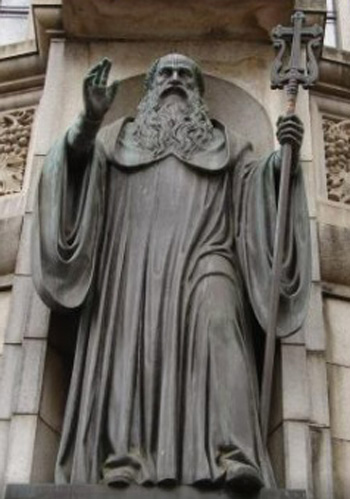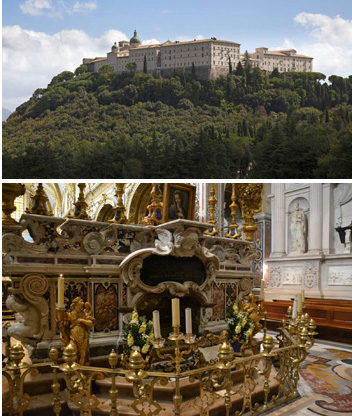Saints of the Day
 |
 |
 |
 |
 |
 |
 |
St. Benedict of Nursia – March 21
Comments of Prof. Plinio:
St. Benedict (480-547), Patriarch of the Western Monks, corresponded to divine grace from his childhood by seeking to become more perfect in all his actions and to serve God exclusively.
 His parents – an illustrious family of Nursia – wanted to provide him an education that would allow him to achieve the glories of the world. Toward that end, they sent him to Rome to study in its famous schools.
His parents – an illustrious family of Nursia – wanted to provide him an education that would allow him to achieve the glories of the world. Toward that end, they sent him to Rome to study in its famous schools.
But St. Benedict was dissatisfied with that situation, which obliged him to live in the corrupted milieu of Rome at that time. He resolved to completely break with the world and fled to the desert.
Today, people tend to think that those wild places where the holy hermits retreated were completely free of temptations and, therefore, this flight to the desert was an act of cowardice.
This is not true. Indeed, a great strength of will was demanded of the hermits to remain for long years removed from all contact with the world, and St. Benedict puts to rest this gratuitous assumption by revealing to us the temptations he suffered.
The temptations he suffered on the mountain of Subiaco, where he went and stayed for three years in a cave above the lake, were so enormous that at times he had to throw himself into patches of thorns to conquer his passions. By these extraordinary means he attained a complete victory of the spirit over the flesh.
Our Lord desired, however, that the glory of His son should shine throughout the world, and that Benedict should win a great number of souls to the cause of Our Lord.
So, He revealed to a holy priest where St. Benedict was living and, after a while, the number of persons who wanted to live under his direction was so large that he had to build 12 monasteries to shelter them. Thus, the famous Benedictine Order began.
 Gifted with a prophetic spirit and the power to work miracles, St. Benedict made an enormous apostolate in his time, preaching more by his example of an austere and irreprehensible life than by his words.
Gifted with a prophetic spirit and the power to work miracles, St. Benedict made an enormous apostolate in his time, preaching more by his example of an austere and irreprehensible life than by his words.
His relics are conserved in great part at the Abbey of Monte Cassino, which was founded by Benedict in Italy.
The world often invents incomprehensible pretexts to hide its own sins and diminish the glory of the Saints in the Church. When the Church presents to her faithful a Saint who lived in the world, overcoming its many temptations because God gave him the grace to conquer them and, indeed, called him to do so, then the world is quick to try to find imperfections in the Saint’s life by alleging that the Saint did not have the courage to endure the recollected hermit’s life.
When the Church shows us a Saint who passed all his life in the desert or in the recollection of monastery, the world accuses him of being incapable of living in the world and, therefore, of being a weak man.
Both types of Saints, however, are heroes, since they have to conquer themselves and overcome the enormous trials and difficulties they encounter – either inside or outside the world. By making accusations against both types of Saints, the world is only looking for pretexts to belittle them so that it can continue to be what it is, that is, it attacks the Saints to justify itself.
Hence, the Catholic must not listen to what the world tells him because the world always finds the way to speak against him. The world will only stop criticizing a Catholic when he compromises with its errors by not fulfilling his duties.
O Legionário, March 20, 1938.

See St. Scholastica
St. Benedict (480-547), Patriarch of the Western Monks, corresponded to divine grace from his childhood by seeking to become more perfect in all his actions and to serve God exclusively.

A majestic statue of St. Benedict
But St. Benedict was dissatisfied with that situation, which obliged him to live in the corrupted milieu of Rome at that time. He resolved to completely break with the world and fled to the desert.
Today, people tend to think that those wild places where the holy hermits retreated were completely free of temptations and, therefore, this flight to the desert was an act of cowardice.
This is not true. Indeed, a great strength of will was demanded of the hermits to remain for long years removed from all contact with the world, and St. Benedict puts to rest this gratuitous assumption by revealing to us the temptations he suffered.
The temptations he suffered on the mountain of Subiaco, where he went and stayed for three years in a cave above the lake, were so enormous that at times he had to throw himself into patches of thorns to conquer his passions. By these extraordinary means he attained a complete victory of the spirit over the flesh.
Our Lord desired, however, that the glory of His son should shine throughout the world, and that Benedict should win a great number of souls to the cause of Our Lord.
So, He revealed to a holy priest where St. Benedict was living and, after a while, the number of persons who wanted to live under his direction was so large that he had to build 12 monasteries to shelter them. Thus, the famous Benedictine Order began.

Top, Mount Cassino Abbey; bottom, behind the altar are St. Benedict’s & St. Scholastica’s relics
His relics are conserved in great part at the Abbey of Monte Cassino, which was founded by Benedict in Italy.
The world often invents incomprehensible pretexts to hide its own sins and diminish the glory of the Saints in the Church. When the Church presents to her faithful a Saint who lived in the world, overcoming its many temptations because God gave him the grace to conquer them and, indeed, called him to do so, then the world is quick to try to find imperfections in the Saint’s life by alleging that the Saint did not have the courage to endure the recollected hermit’s life.
When the Church shows us a Saint who passed all his life in the desert or in the recollection of monastery, the world accuses him of being incapable of living in the world and, therefore, of being a weak man.
Both types of Saints, however, are heroes, since they have to conquer themselves and overcome the enormous trials and difficulties they encounter – either inside or outside the world. By making accusations against both types of Saints, the world is only looking for pretexts to belittle them so that it can continue to be what it is, that is, it attacks the Saints to justify itself.
Hence, the Catholic must not listen to what the world tells him because the world always finds the way to speak against him. The world will only stop criticizing a Catholic when he compromises with its errors by not fulfilling his duties.
O Legionário, March 20, 1938.
 | |
|
|
The texts of both the biographical data and the comments come from personal notes taken by Atila S. Guimarães from 1964 to 1995. Given the fact that the source is a personal notebook, it is possible that at times the biographic notes transcribed here will not rigorously follow the original text read by Prof. Plinio. The commentaries have also been adapted and translated for TIA’s site.